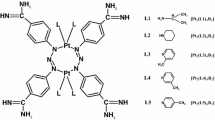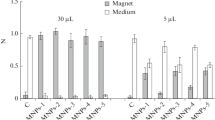Cytometric and ultrastructural studies on 24 hr cultures of intact, 1.0 mM H5I06, and 0.1 mM SeO2-oxidized HuT-78 lymphoblasts were performed after their direct, 30 min interaction with 1.0 mM NiCl2. Except for moderately depressed cell viability, divalent nickel did not alter the progression of intact and oxidized target cells through the phases of the cell cycle.
Although the plasma membrane remained structurally intact, marked distortion of mitochondria structure and increased osmiophilia were an invariable attribute of all nickel-pulsed cells. Moreover, numerous electron-opaque, intracellular depositions were detected in SeO2-oxidized, nickel-pulsed cells. It is concluded that the initial state of plasma membrane, and the interaction of nickel with other trace elements, have jointly determined the response of HuT-78 cells to brief and direct, divalent nickel pulses.
Similar content being viewed by others
References
ABBRACHIO, M.P., EVANS, R.M., HECK, J.D., CANTONI, O., and COSTA, M. (1982). “The regulation of ionic nickel uptake and cytotoxicity by specific amino acids and serum components.” Biol. Trace Element Res. 4:289–301.
ANKEL-FUCHS, D. THAUER, R.K. (1988). “Nickel in biology: nickel as an essential trace element.” In: The Bioinorganic Chemistry of Nickel (J.R. Lankaster, ed.) VCH Publishers Inc., New York, NY. pp. 93–110.
BERRY, J.P., POUPON, M.F., JUDDE, J.C., and GALLE, P. (1985). “In vitro electron microprobe of carcinogenic nickel compound interaction with tumor cells.” Ann. Clin. Lab. Sci. 15:109–120.
BLAKLEY, B.R. (1987). “Alterations in urethan induced adenoma formation in mice exposed to selenium and nickel.” J. Appl. Toxicol. 7:387–390.
COSTA, M., CANTONI, O., DEMARS, M., and SWARTZENDRUBER, D.E. (1982). “Toxic metals produce an S-phase-specific cell cycle block.” Res. Comm. Chem. Path. Pharmacol. 38:405–419.
DiPAOLO, J.A. and CASTO, B.C. (1979). “Quantitative studies ofin vitro morphological transformation of Syrian hamster cells by inorganic metal salts.” Cancer Res. 39:1008–1013.
DRAKE, H.L. (1988). “Biological transport of nickel.” In: The Bioinorganic Chemistry of Nickel. (J. R. Lankaster, ed.) VCH Publishers Inc., New York, NY. pp. 111–139.
EBERT, P.S. and MALININ, G.I. (1979). “Induction of erythroid differentiation in Friend murine erythroleukemic cells by inorganic selenium compounds.” Biochem. Biophys. Res. Comm. 86:340–349.
EVERNESS, K.M., GAWKRODER, D.J., BOTHAM, P.A., and HUNTER, J.A. (1990). “The discrimination between nickel-sensitive and non-nickel sensitive subjects by anin vitro lymphocyte transformation test.” Br. J. Dermatol. 122:293–298.
GLENNON, J.D. and SARKAR, J.D. (1982). “Nickel (II) transport in human blood serum.” Biochem. J. 203:15–23.
GOOTENBERG, J.E., RUSCETTI, F.W., MIER, J.W., GAZDAR, A. and GALLO, R.A. (1981). “Human cutaneous T-cell lymphoma and leukemia cell lines produce and respond to T-cell growth factor.” J. Exp. Med. 154:1403–1418.
GURD, F.R.N. and WILCOX, P.E. (1956). “Complex formation between metallic cations and proteins, peptides and amino acids.” Adv. Protein Chem. 11:311–427.
HARNETT, P.B., ROBINSON, S.H., SWARTZENDRUBER, D.E., and COSTA, M. (1982). “Comparison of protein, RNA and DNA binding and cell cycle specific cytotoxic effects of nickel compounds in cultured cells.” Toxicol. Appl. Pharmacol. 64:20–30.
HILDEBRAND, H.F., DECAESTECKER, A.M., ARROUIJAL, F.Z., and MARTINEZ, R. (1991). “In vitro andin vivo uptake of nickel sulfides by rat lymphocytes.” Arch. Toxicol. 65:324–329.
HORNICEK, F.J., MALININ, G.I., GRATZNER, H.G., and MALININ, T.I. (1985). “The interaction of bisulfite and its free radical analog-nitroxyldisulfonate with periodic-acid oxidized lymphocytes and their effect on blastogenesis.” Chem-Biol. Interactions 55:289–302.
HORNICEK, F.J., MALININ, G.I., THORNTHWAITE, J.T., and MALININ, T.I. (1986). “Flow cytometry of blastogenesis and the concomitant viability assay of lymphocytes stained with 4′,6 diamidino-2-phenylindole.” Bas. Appl. Histochem. 30:453–461.
HUTCHINSON, F., RAFFLE, E.J., and McCLEOD, T.M. (1972). “The specificity of lymphocyte transformation in vitro by nickel salts in nickel sensitive subjects.“ J. Invest. Dermatol. 58:362–365.
KHANDELWALS, S., FLORA, S.J.S., and TANDON, S.K. (1990). “Nickel-selenium interaction-time dependent biochemical alterations and metal decorporation in rats.” Chem-Biol. Interactions 75:341–347.
LECHNER, J.F., TOKIWA, T., McCLENDON, I., and HAUGEN, A. (1984). “Effects of nickel sulfate on growth and differentiation of normal human bronchial epithelial cells.” Carcinogenesis 5:1697–1703.
LUCASSEN, M. and SARKAR, B. (1979). “Nickel(II)-binding constituents of human blood serum.” J. Toxicol. Environ. Health 5:897–905.
MAINES, M.D. (1980). “Nickel alterations of heme biosynthesis and degradation: implications for the oxidative metabolism of drugs and carcinogens.” In: Nickel in the Environment (J. O. Nriagu, ed.) John Wiley & Sons, Inc., New York, NY. pp. 569–583.
MALININ, G.I., HORNICEK, F.J., and EBERT, P.S. (1983). “Comparative activation response of splenocytes oxidized by periodic acid and selenium dioxide.” Res. Comm. Chem. Path. Pharmacol. 41:425–439.
MALININ, G.I., HORNICEK, F.J., and MALININ, T.I. (1990). “Direct oxidation of lymphocytes by chromic acid does not induce blastogenesis.” Biosci. Rep. 10: 347–352.
MILNER, J.A. and HSU, C.Y. (1981). “Inhibitory effects of selenium on the growth of L1210 leukemic cells.” Cancer Res. 41:1652–1656.
NIEBOER, E., STAFFORD, A.R., EVANS, S.L., and DOLOVICH, J. (1984). “Cellular binding and/or uptake of Ni(II) ions.” In: Nickel in Human Environment (F.W. Sunderman, Jr., ed.) Oxford University Press, Oxford, UK. pp. 321–331.
NIELSEN, F.H. (1980). “Interaction of nickel with essential minerals.” In: Nickel in the Environment (J.O. Nriagu, ed.) John Wiley and Sons, New York, NY. pp. 569–583.
NORDLIND, K. and HENZE, A. (1984). “Investigation of ability of the metal allergens cobalt chloride, nickel sulfate and potassium dichromate to give a mitogenic response in human thymocytes.” Int. Arch. Allergy Appl. Immunol. 75:330–332.
NORDLIND, K. (1984). “Further studies on the lymphocyte transformation test in diagnosis of nickel allergy.” Int. Arch. Allergy Appl. Immunol. 75:333–336.
NORDLIND, K. (1985). “Nickel binding and uptake in thymocytes and peripheral blood lymphocytes of nickel-allergic and control subjects.” Int. Arch. Allerg. Appl. Immunol. 78:365–367.
PESSANO, S., McNAB, A. and ROVERA, G. (1981). “Growth and differentiation of human and murine erythroleukemia cell lines in serum-free synthetic medium.” Cancer Res. 41:3592–3596.
RIPPA, M., BELLINI, T, SIGNORINI, M., and DALLOCCHIO, F. (1981). “Evidence for multiple pairs of vicinal thiols in some proteins.” J. Biol. Chem. 256: 451–455.
SEN, P. and COSTA, M. (1985). “Induction of chromosomal damage in Chinese hamster ovary cells by soluble and particulate nickel compounds; preferential fragmentation of heterochromatic long arm of the X-chromosome by carcinogenic crystalline NiS particles.” Cancer Res. 45:2320–2325.
SINGAGLIA, F., SCHEIDEGGER, D., GAROTTA, G., SCHEPER, R., PLETSCHER, M., and LANZAVECCIA, A. (1985). “Isolation and characterization of Ni-specific T-cell clones from patients with Ni-contact dermatitis.” J. Immunol. 135:3929–3932.
SODA, K., TANAKA, H. and ESAKI, H. (1987). Biochemically and physiologically active selenium compounds. In: The Chemistry of Organic Selenium and Tellurium Compounds vol. 2 (S. Patai, ed.). John Wiley & Sons, New York, NY. pp. 349–366.
SUNDERMAN, F.W. Jr. (1976). A review of the carcinogenicities of nickel, chromium and arsenic compounds in man and animals. Prev. Med. 5:279–294.
SUNDERMAN, F.W. Jr. and MASTROMATTEO, E. (1975). “Nickel carcinogenesis.” In: Nickel (F. W. Sunderman, Jr., F. Coulston, G.L. Eichorn, J.A. Fellow, E. Mastromatteo, H.T. Reno, and M.H. Samitz, eds.) Natl. Acad. Sci., Washington, DC. pp. 144–148.
THORNTHWAITE, J.T., THOMAS, R.A., RUSSO, J., OWNSBY, H., MALININ, G.I., HORNICEK, F.J., WOOLLEY, T.W., FREDERICK, J., MALININ, T.I., VASQUEZ, D.A., and SECKINGER, D. (1985). “A review of DNA flow cytometric preparatory and analytical methods.” In: Immunocytochemistry in Tumor Diagnosis (J. Russo, ed.). Martinus Nijhoff, Boston, MA. pp. 380–398.
WATSON, R.R., MORIGUCHI, S., McRAE, B., TOBIN, L., MAYBERRY, J.C., and LUCAS, D. (1986). “Effects of seleniumin vitro on human T-lymphocyte functions and K-562 tumor cell growth.” J. Leukocyte Biol. 39:447–456.
WEBB, M. and WEINZIERL, S.M. (1972). “Uptake of63Ni2++ from its complexes with proteins and other ligands by mouse dermal fibroblasts.” Br. J. Cancer 26:292–298.
Author information
Authors and Affiliations
Rights and permissions
About this article
Cite this article
Malinin, G.I., Hornicek, F.J., Lo, H.K. et al. Cytometric and electron microscopic studies of the direct interaction of divalent nickel with intact and chemically modified HuT-78 lymphoblasts. Cell Biol Toxicol 8, 27–41 (1992). https://doi.org/10.1007/BF00119293
Received:
Accepted:
Issue Date:
DOI: https://doi.org/10.1007/BF00119293




